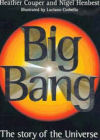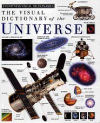A whole lot of nothing Additional Information
Visit Larry Rudnick’s Web site at webusers.astro.umn.edu/~larry(University of Minnesota).
To learn more about the cosmic microwave background radiation (CMB), see map.gsfc.nasa.gov/m_uni/uni_101bbtest3.html(NASA).
The Wilkinson Microwave Anisotropy Probe (WMAP) satellite has been orbiting Earth and mapping the CMB since 2001. For more information, go to map.gsfc.nasa.gov/(NASA)
For more information about the Very Large Array, a radio telescope in New Mexico, visit www.vla.nrao.edu/(National Radio Astronomy Observatory).
Jaffe, Eric. 2006. Dark collision. Science News for Kids (Aug. 30). Available at http://www.sciencenewsforkids.org/articles/20060830/Note2.asp.
Sohn, Emily. 2005. Supernovas shed light on dark energy. Science News for Kids (Dec. 12). Available at http://www.sciencenewsforkids.org/articles/20051221/Note3.asp.
______. 2005. Dark galaxy. Science News for Kids (March 2). Available at http://www.sciencenewsforkids.org/articles/20050302/Note2.asp.
______. 2004. Strange universe: The stuff of darkness. Science News for Kids (Feb. 11).
Available at http://www.sciencenewsforkids.org/articles/20040211/Feature1.asp.
______. 2003. The mirror universe of antimatter. Science News for Kids (Oct. 15).
Available at http://www.sciencenewsforkids.org/articles/20031015/Feature1.asp.
______. 2003. A galaxy far, far, far away. Science News for Kids (April 16). Available at
http://www.sciencenewsforkids.org/articles/20030416/Note2.asp.
______. 2003. Phantom energy and the big rip. Science News for Kids (March 12). Available at http://www.sciencenewsforkids.org/articles/20030312/Note3.asp.
Books recommended by SearchIt!Science:
 |
Big Bang: The Story of the Universe — Heather Couper
Published by DK Publishing, 1997.
“From nothing, a tiny speck of brilliant light appeared.” Scientists can’t explain how or why “nothing” became “something.” That speck expanded until one day it exploded. So began the formation of the universe. This book takes you step by step through the creation process. Color photos, drawings, a glossary, and an index help you learn more about this fascinating subject. |
 |
The Visual Dictionary of the Universe — Martyn Bramwell
Published by Dorling Kindersley, 1993.
Scientists don’t know exactly how big the universe is, but some think that it contains 100 billion galaxies. Each galaxy contains an average of 100 billion stars. With more than 200 color photographs, illustrations, and charts, this Eyewitness Book provides a close-up view of the details of our universe. Asteroids, stars, star clusters, nebulae, the Milky Way, galaxies, and each of the planets in our solar system are pictured and described. The book also discusses space exploration. A summary of astronomy data is included, in addition to a glossary and an index. |
 |
Deep Space Astronomy— Gregory L. Vogt
Published by Twenty-First Century Books/Millbrook Press, 1999.
Do you find information on outer space totally mind-boggling?This technical book explains the history of outer space as well as our current knowledge about it. It is full of color photos and provides multiple examples to help you to visualize the difficult concepts. |
Power Words
Big Bang The powerful explosion of a tiny, very hot object that contained all the matter in
the universe. Scientists believe that the big bang was the first thing that happened in the history of the universe, sometime between 12 and 18 billion years ago.
radiation 1. Energy in the form of electromagnetic waves or streams of particles, such as photons or electrons. Radiation is given off when the nuclei of radioactive atoms break down into smaller parts. 2. The use of x-rays or other electromagnetic waves to treat diseases, especially cancer.
radio astronomy The branch of astronomy dealing with the detection of objects in space by means of the radio waves that these objects emit.
Copyright © 2002, 2003 Houghton-Mifflin Company. All rights reserved. Used with permission.
